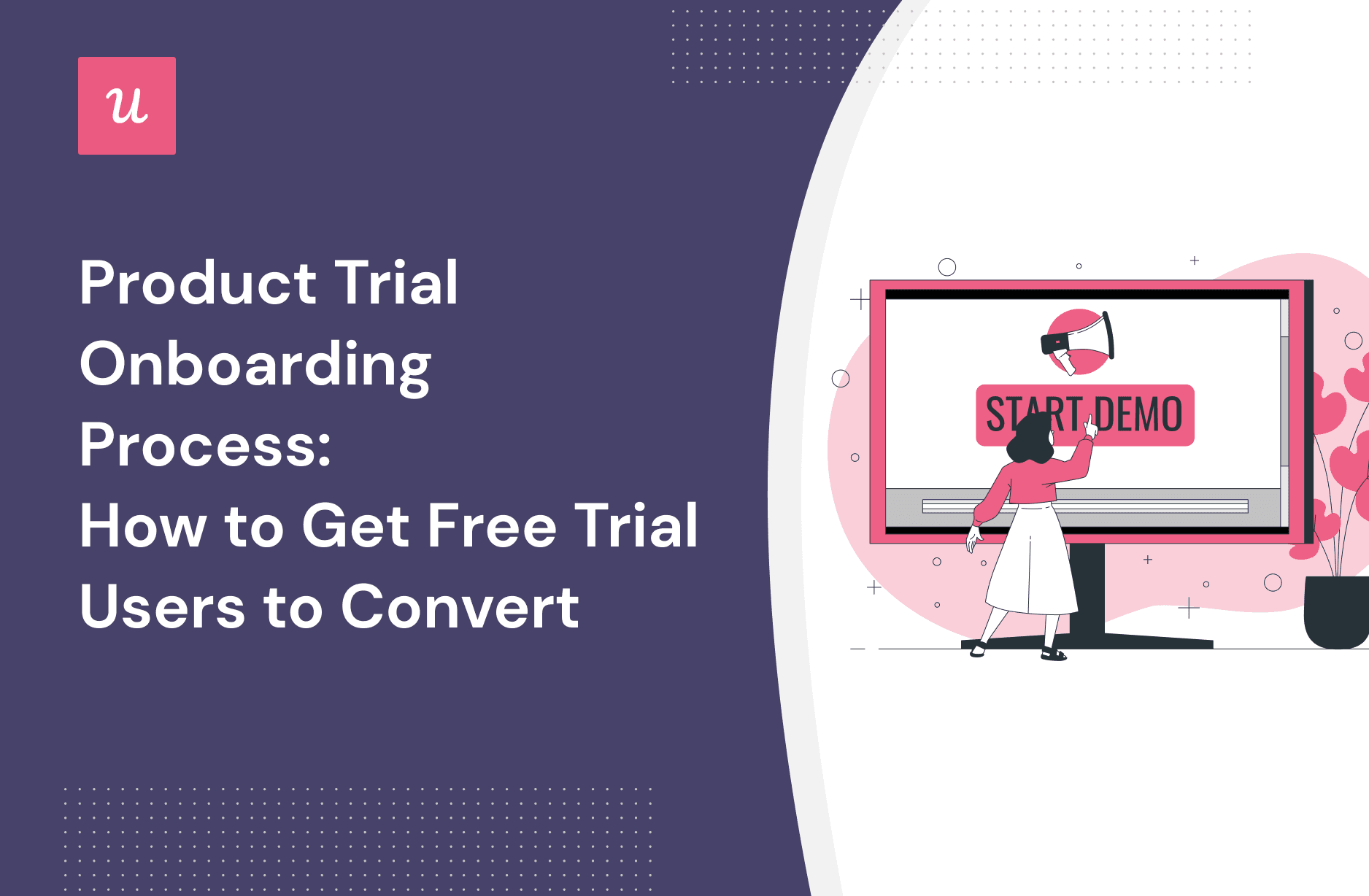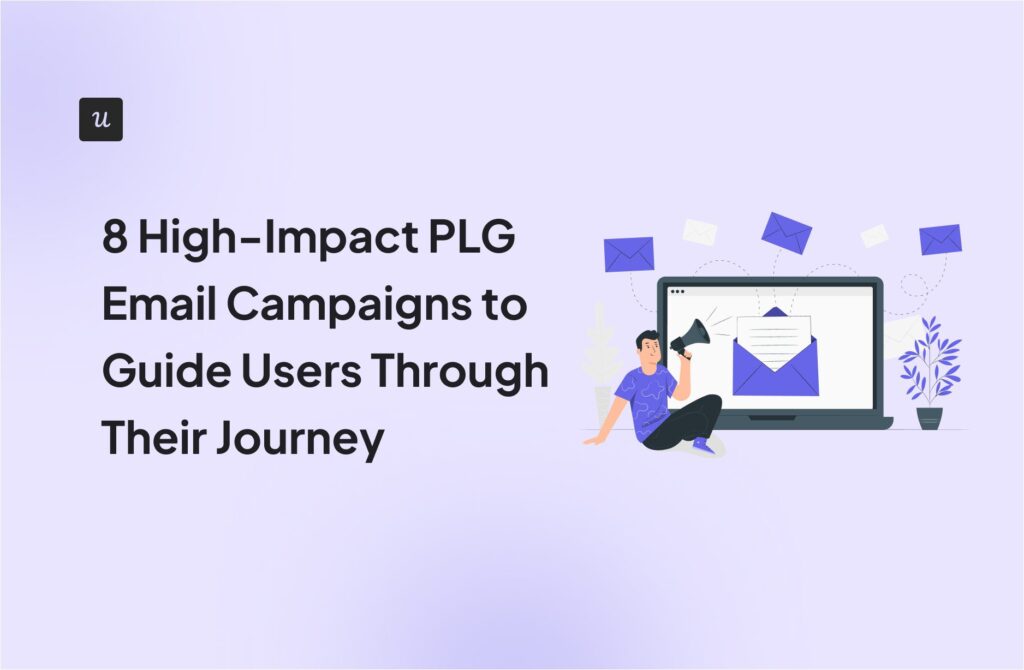
Product Trial Onboarding Process: How to Get Free Trial Users to Convert
Figuring out how to get users to part with their hard-earned cash and actually pay for your product is a big challenge. It could be product trial onboarding that helps you figure out how to solve it.
In this blog, we’ll explore what a product trial is, describe the onboarding process, and give you the tools you need to apply it in your own SaaS.
Ready to get started? Let’s get into it!
Get The Insights!
The fastest way to learn about Product Growth, Management & Trends.
What is a product trial?
A product trial is one aspect of a product-led growth strategy. Essentially, using the product itself as a way to attract, engage and convert users into paid customers.
Rather than try to convince and encourage users with marketing techniques, you let them try out the actual functionality – and let your features do the talking.
Types of product trials in SaaS businesses
There are several different varieties of product trials to consider, each with pros and cons. Some are optimized for maximizing app usability, others for conversion.
Choose carefully:
- Free trial, limited features: This gives users a taster of your product by letting them use some of the functionality – absolutely free. The thinking is the time they spend inside your product will convince them to upgrade.
- The paid trial, full access: Another option is to adjust your usual payment structure by offering a smaller ‘slice’ (i.e. not a full year – potentially just a couple of weeks). This technique is commonly used by online publications and magazines to entice customers into extending the trial into a full membership by demonstrating the breadth of material available.
- Freemium: Made famous by-products like Spotify, this is essentially a lower-tier of membership – often subsidized by advertising – that allows customers to use your product without paying directly for it. Over time, you’ll convert a portion of freemium users into paying customers.
- Reverse trials: Combining aspects of the above, a reverse trial provides customers with a time-boxed free trial – including access to paid capabilities – which reverts to a freemium product after the free trial ends.

What is the product onboarding process?
Onboarding is a broad term describing the range of activities about getting customers into and experiencing value from your product.
It’s not a ‘once and done’ activity.
There are various different phases to consider, but they’re all driving toward the goal of adoption.
The diagram below demonstrates how the onboarding maps onto the entire customer lifecycle: you need to carefully design your onboarding process to move your users from one stage to the next.

Why do you need to onboard new users during the trial?
User onboarding is extremely important to ensuring effective product trials. You want to make sure you’ve got customers engaged from the initial sign-up right the way through.
Ultimately, the right guide and prompt at the right time will help put the user on the right path to activation – and reduce their time to value.
Let’s explore two of the key drivers.
Onboarding users drives higher product activation rates
Firstly, onboarding helps boost user activation by providing a clear sequence of activities from the moment a user signs up.
Without the solid structure of customer onboarding – designed to help your customers unlock value – you run the risk of your users wandering aimlessly around your product.
That inevitably means customer churn.
Onboarding trial users increases retention
Another benefit of implementing a customer onboarding process as part of your product trials is the impact on retention.
Simply put, activated users (i.e. those who’ve experienced value from using your product) are far more likely to keep using your application.
They have evidence it’s worth their while, so their conversion to paid customers is a far simpler exercise.
The elements of a good customer onboarding process for trial users
So what exactly goes into an effective onboarding process? Let’s break down the key elements.
Sign-up page
You can think of this as the digital equivalent of a ‘store front’: your sign-up page is a key element to get right in user onboarding.
You’ll need to strike a balance between communicating a clear value proposition and gathering ‘just enough’ information to qualify users (without making it tricky to access your product).

Sign-up process
This is the next stage of user onboarding: from the sign-up screen, into the sign-up process.
You need to bear in mind the same balance as before.
While you want to gather as much information as possible throughout the customer onboarding process (like pain points, company info, etc), you don’t want to make it tricky for them to sign up.
A frictionless sign-up flow – potentially by implementing SSO – is the fastest route, but means you’ll sacrifice an opportunity to gather valuable information. However, it’s what many users will expect now.
If you do need to collect more data, add a progress bar (like Fullstory) and split the process onto multiple screens to avoid cognitive friction.

The blank slate
The next element of the customer onboarding process?
Populating the ‘blank slate’ with personal information gives users a fantastic first impression of your product. Otherwise, they’ll be faced with a cold, impersonal, unfamiliar interface – not exactly a warm welcome!
Landing smoothly in your product is critical for them to take subsequent steps toward activation. Adding an action prompt, like Airtable, will do the job.
It helps users get off to a fast start, and much closer to obtaining value from your product.

UX engagement prompts
At this stage of the customer onboarding process, you’ve successfully managed to get users signed up and landed within your product.
But that’s not enough.
You need to engage them within the tool itself. There are various UX engagement prompts to consider – depending on the context – that can help create a more interactive experience: modals, tooltips, checklists, and walkthroughs are just some of the tools at your disposal.

Customer feedback
As we discussed earlier, onboarding is not ‘once and done’.
You need to gather feedback to help you understand where users struggle, and their pain points, and spot opportunities for improvement.
Use targeted surveys to gather insight at key points in the journey. Keep them short and to the point – targeting relevant user groups – to avoid frustration.

In-app self-serve support
Customer onboarding is never going to be completely plain sailing.
Customers are always going to have their fair share of issues and challenges: so make sure to give them the tools to solve their own problems.
You can do that with a help center within your app to provide contextual help. Embed onboarding videos, how-to guides, best practices, and more within your knowledge base to give users the most effective experience.

Product onboarding process best practices to retain users after a trial
Now, why would you kick off a trial in the first place?
You’re hoping to hang on to your users. Let’s explore some of the best practices and techniques for doing exactly that after your trial is complete.
Collect data to understand new customers’ goals
A welcome screen is your product’s front door. Many organizations send welcome emails that serve a similar purpose: yes, to welcome customers to your app, but also as a way to gather valuable data.
Check out this great example below. It gets right to the point of why a customer has signed up, and what they’re hoping to achieve – with one simple question.

Use data for a personalized onboarding experience
The next step to retain your customers is to consistently deliver a relevant, targeted, personalized experience.
Use the data you’ve gathered to understand the distinct user groups, then target activities and flows directly to the relevant segments.
For example, you might launch a particular checklist or in-app prompt to one group, and opt for a tooltip for another – all depending on the user’s need.

Help users get to the activation point fast
If you want to retain your customers, here’s a guiding principle: help users reach the activation point as quickly as humanly possible.
Your mission should be to help users experience value.
Checklists are an excellent way of doing exactly that. They help drive customers toward the next actionable step, helping them to uncover particular features without suffering from information overload.

Guide users with interactive product tours
Sometimes, a prompt isn’t enough. You need to take your users by the hand and guide them step by step through engaging with a particular feature.
Building an interactive walkthrough is your best bet here.
They’re a far better option than long, boring, and often irrelevant product tours. Chain tooltips together that launch only when the relevant action has been taken.

Re-engage inactive users with onboarding emails
You can’t rely purely on in-app messaging. Sometimes, targeted communication that lands directly in your users’ inbox is the best way forward.
If you understand their needs – and where you left off – it’s easy to reestablish a connection with your inactive user base. A tempting offer might draw them back in.

Use gamification to drive engagement
Gamification is an enormous trend in the SaaS world. It’s a proven technique for engaging and generating value for your customers.
In a nutshell, giving people the feeling they are ‘winning’ vastly increases the likelihood they’ll engage with a specific feature.
The example below shows exactly how gamification can directly lead to better product outcomes. Think about how you can leverage similar offers in your own product.

Gather customer feedback before the free trial ends
It’s not a case of converting users from a trial. You need to keep working to understand their needs over time.
Not only does that give you a better chance of successfully iterating your service to meet their evolving needs, but it also improves things for future customers.
Gather customer feedback however you can – surveys are particularly effective – and make sure you start before the trial ends.

Encourage users to upgrade at the right time
A key skill for savvy product managers is timing: understanding when to take key decisions.
An important element of that is when you try to upsell your customers.
Go too soon, and you run the risk of disengaging them (and failing to convert them). Go too late, and you miss a golden opportunity to convert interested customers and drive revenue.
Use modals, prompts, or other UX patterns – depending on the context – and choose when you reach out carefully.

Best tools for automating the customer onboarding process and driving customer success
Now, of course, it’s impossible to implement any of the tactics and techniques we’ve discussed without the right tool for the job.
It’s a crowded, dynamic marketplace and there are dozens of tools available, but one stands out from the crowd: Userpilot.
Userpilot is a powerful product adoption platform that enables you to quickly build personalized, flexible, contextually relevant in-app experiences targeted to different user segments – all without writing a line of code.
- Out of the box: Userpilot comes with an easy-to-use Chrome Extension builder.
- Multiple UI patterns: Choose from a range of options to build customized flows: modals, slideouts, banners, tooltips, hotspots, and checklists are all at your disposal.

- Analytics and segmentation: Advanced analytics and user segmentation capabilities alongside in-depth feature tagging to understand the performance of specific areas of your app.

Conclusion
We’ve covered an awful lot – let’s recap.
Product trials are a powerful tool for generating interest, attracting new customers, and hopefully converting them. There are several types of trial: from freemium to a ‘reverse trial’, and you’ll have to choose carefully based on your needs. They help engage and retain users.
Want to get started with generating effective trials? Get a Userpilot Demo and see how you can craft impactful product trials that enthrall your customers today.






